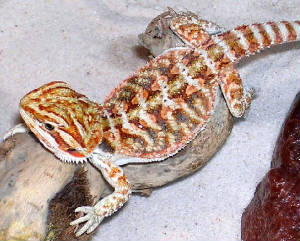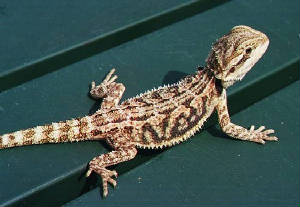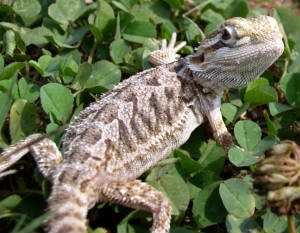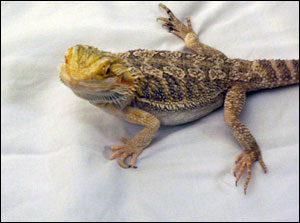|
Introduction
Bearded Dragon are gentle beasts they come form australia but are avalible to the us because of there
willingness to breed in captivity. These are great pets for anyone who will dedicate there time. They are recently
quite popular due to small size and docile nature. They can get to the size of 12-20 inches. Bearded Dragond are
perfect for familes with small children due to there amount of attention they will give.
Choosing your Bearded Dragon
When you decide to buy a Bearded Dragon whether from a breeder or a pet store, look over it carfully. One
of the first few things you should notice is the how alert and active the Bearded Dragon is, you dont want a Bearded Dragon
that cant lift its head or look lethargic. When you walk up to the enclosure the Bearded Dragons should be watching you
with interest and should have bright and alert looking eyes. You will also want to check them for sores, burns, external parasites
or any deformities. Do make sure there is no pus or other gunk built up in the eyes, nose or mouth area also. Lots of
Bearded Dragons will be missing toes or pats of there tail, this will not cause them any pain as long as the wound looks
healed and shows no sign of infection. One of the most important thing to me that look for is the size of the Bearded
Dragon. I would not get a Bearded Dragon that is under 6 inches in total length. Baby Bearded Dragons are very fagile
and more prone to become ill or over stressed. I think it would be much easier to care for a more developed Bearded Dragon.
Housing
For a Bearded Dragon under 10 inches in length i suggest a 20 gallon or a 30 gallon aquarium. This
will last a few months because they grow quickly. A single adult Bearded Dragon should be housed in nothing smaller than
a 40 gallon breeder tank. I would suggest the 55 gallon aquarium because of the extra room for the Bearded Dragon to run,
as well as there are easily found in pet stores. You should you nothing other than a screen lid in the approprate
size. Do not use glass, plexiglass or wood to cover your cages. This will not allow enough air circulation and will
also trap humidity in the cage. Screen tops allow air flow as well as it will allow your lighting and heat sources to
work correctly and allow humity to escape.
Lighting
Bearded Dragons require full spectrum lighting for 12-14 hours a day. I would suggest the Reptisun
5.0 or 8.0 fluorescent bulbs. There are of course other brands available like Reptiglo or lumichrome bulbs. These
fluorescent bulbs should stretch the length of your Bearded Dragons enclosure, and you Bearded Dragon should be able to come
within 6-8 inches of the light. The UV light should be placed over the cage and not direacted throughthe glass, because
glass deflects the UV rays. Follow the intruction on the bulbs box for how ofen to replace bulb.
Heating and Temperature
To produce heat and a basking spot in your enclosure you can use either a ceramic heat emitter,
a reptile basking light(red, blue or white) or just a plain old household lightbulb. The best fixture for any of these
choices is a porcelain dome light fixture. This type of fixture is a must with a ceramic heat emitter due to the amount
of heat they produce. The temperature for this basking spot you created should be around 110f for juveniles and can be
around 95f for adults. Allthough I don't recommend any temps above 110f, within a few degrees of these basking temps
will be sufficent. The cool side of the enclosure should be around 85f during the day. Once again within a few degrees
of this temperature is just fine. Night time temperatures can fall as low as 70f. It is fairly easy to keep your
night temperatures above this even in the winter. If you can't keep your temperatures above this I suggest
that you consider buying an under tank heater for night time use. Using this just during the evening hours will
help create a warm spot for your Dragon to sleep. Do not use heat rock for these can cause serious burns on your Bearded
Dragons underside. A thermometer in the "hot side" and one in the "cool side" will make sure that your temperatures
are in the range they should be in.
Substrate
For baby to juvenile Bearded Dragons I suggest either newspaper, paper towels, butcher paper or reptile
carpet. These choices are cheap, easy to clean and hold no health risks to your animal. If using reptile carpet
the stuff that looks and feels like grass is the best. The felt kind has little loops of fabric that may catch the nails
of your Bearded Dragon and cause injury. Do not use sand, shavings or any other loose substrate
for baby to juvenile Bearded Dragons. They can be very clumsy eaters and they are also very curious and like to
taste everything. Any kind of loose substrate holds serious health risks to your Bearded Dragon. If they eat
a loose substrate they can become impacted, which is a blocking of the intestines, and die. For adult Dragons I sugest
the grass repti carpet or Vita-Sand from ZooMed. Which only cost about 4.99 for a 5 pound bag.
Feeding and Diet
Bearded Dragons are omnivorous, meaning that they eat both animals and plants. Any and all food items that your Bearded
Dragon eats should be no bigger than the space between their eyes. If the food items are bigger than the space between
their eyes it can cause impaction and/or hind leg paralysis. Either way your Bearded Dragon will suffer horribly.
Baby and juvenile Bearded Dragons should be offered the appropriately sized crickets two-three times a day. Offer
as many as your Bearded Dragon will eat in a 5-10 minute time frame. When your Bearded Dragon stops eating, stop offering
and remove any uneaten crickets. Young Bearded Dragons can eat anywhere from 20-60 small crickets a day. Your Bearded
Dragon should also be given fresh greens daily. By spraying the greens with water it will help them last longer
and will also help keep your Bearded Dragon hydrated. Sub-adult to adult Bearded Dragons only need to eat prey items
once a day along with fresh greens. Once they are this age you can also offer them Locusts, Cockroaches, Mealworms, Waxworms,
Zophobas worms, Silkworms, Butterworms, Red worms, Earthworms and just about any other worm available. All these should be
used as treats though with crickets and greens being the stable part of your Bearded Dragons diet. Do not feed your
Bearded Dragon insects that you have caught in your backyard. These bugs could have parasites that could be passed on
to your Bearded Dragon or they could have been exposed to poisons that could kill your Bearded Dragon. Lightning bugs can also kill your Bearded Dragon so it is much safer to stay away from wild caught
insects. Prey items should be dusted once a day with a calcium/vitamin D3 supplement such as Rep-cal makes. All prey items
should be dusted once a week with a multivitamin supplement such as Herptivite, also made by Rep-cal.
There is a wide variety of greens that are available that are good for your Bearded Dragon. Dandelion greens, Collard greens,
Mustard greens, Bok choy, Kale, Turnip greens, Escarole and Chicory are among the easiest to find and the best to use. If
the greens you are wondering about say Lettuce anywhere in the name avoid them. Most types of lettuce are composed mostly
of water and hold little or no nutritional value. With the wide variety of other greens out there it is better and easier
to just avoid any type of lettuce. Spinach should also be avoided as calcium binds to it and will not be digested by your
animal. There is a wide variety of vegetables can also be offered to your Bearded Dragon. Butternut squash, Yellow
squash, Spaghetti squash, Acorn squash, all other varieties of squash, Green beans, Parsnips, Sweet potato, Snow peas and
Carrots. Carrots should only be used as a treat though due to the high amounts of vitamin A. Any food with high amounts of
vitamin A should be avoided as reptiles do not absorb alot of vitamin A. Feeding your Bearded Dragon alot foods such
as Carrots will end up in a condition called Vitamin A toxicity wich is deadly. Squashes will either have to be cooked or
microwaved before feeding them to your Bearded Dragon. This will soften them up and they can then be minced and eaten easier.
Fruits can also be used, just avoid any citrus fruit such as oranges and grape fruit.
|
 |
|


Water
Fresh water should be offered daily in a shallow bowl. This water bowl should be disinfected once a week
to avoid any bacterial build up. Many Bearded Dragons may not drink from a water bowl so you may have to drip the water
slowly onto your Bearded Dragons snout. You can try wiggling your finger in the water to get their
attention. Bearded Dragons like things that move, so creating ripples in the water may get their attention.
Bathing
Bathing your Bearded Dragon once a week will help keep them hydrated and will also aid in shedding. Bath
water should be warm on your wrist and not hot, much like bath water for a small child. Make the water only as deep as your
Bearded Dragons chest or half way up their front arms. I usually just fill the tub until the water reaches the second
knuckle on my index finger for my adults and the first knuckle for the juveniles. Never leave your Bearded Dragon unattended
in the bath tub, accidents only take a second to happen. It's also a god idea to disinfect your tub when the bath is over
because Bearded Dragons will often defecate in the water. Or spay them with a squirt bottle for they may not like baths.
Disinfecting
I suggest you use a 1/4 cup of bleach mixed with a gallon of water. This is done easiest in an old, clean, milk container.
After mixing the bleach and water I then fill a spray bottle with the mixture. This makes it easy to cover the entire surface
of what you are cleaning and leaves a container full for when your spray bottle is empty. All surfaces that get feces on them
should be disinfected, including water bowls, food bowls and cages. This is how I suggest you disinfect your
my cage, cage accessories and the tub after bathing. Spray the entire surface of what you are cleaning until it is soaked.
Then let it sit for 15 minutes. After 15 minutes scrub the surface with a rag making sure that any old food or feces
is removed. Rinse all surfaces repetedly until you can no longer smell bleach. If you still smell bleach rinse again, because
bleech is harmful to Bearded Dragons.
Hygiene
Hand washing is very important when owning any reptile. Washing your hands before and after handeling your Bearded Dragon will
help keep you and your new pet healthy. If you wash your hands before handeling you reduce the risk of passing anything on
to your Bearded Dragon. Washing your hands after handling greatly reduce the risk of you contracting salmonella. The
risks of getting this are very slim to begin with but hand washing will even further reduce the risks. Your chances of contracting
salmonella from the food you eat are greater than your chances of getting it from your Bearded Dragon so don't fret.
Miscellious
Before deciding on buying a Bearded dragon you should consider a few things. One, do you have a qualified Herp Vet in your
area that will be able to care for your new pet if it get's sick? Newly aquired Bearded Dragons should always have a fecal
sample tested for parasites and a general health checkup. It is also a good idea to have them retested for parasites once
a year. Two, are you going to be able to afford to feed, house and care for this pet during it's life? Bearded Dragons will
eat like ravenous beasts when young and will cost you alot of money. The UV light they require also need to be replaced around
every six months wich is also going to cost a bit of money. Let's not forget trips to the Vet, these may also add up over
the years of your Bearded Dragons life span. You are responsible for the life of your pets. If they are sick get them
to a good Vet. If they are hungry feed them. Animal abuse is a felony in many states and you should take note of that.


|
 |
|